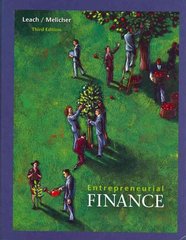Question
Problem 1 (20 Points) Marty Jones is negotiating with a Venture Capital Fund for $10 MIL financing for his new venture. Marty is the sole
- Problem 1 (20 Points)
Marty Jones is negotiating with a Venture Capital Fund for $10 MIL financing for his new venture. Marty is the sole founder and owns 100% of the companys equity. He is adamant that he must keep a 60% interest in the company after external capital is raised.
A VC investor believes an 10X return in NLT 5 years is an appropriate return for the risk associated with this investment.
The company has just begun generating revenue, and it does not expect to generate positive Cash Flow (CF) until Year 2. Discreet Cash Flow projections prepared from pro forma financial statements are presented below. After the discreet forecasting period (Yr 4), Rick and the VC expect CFs to grow by 3.5% per year in perpetuity.
| Year | Cash Flow |
| 1 | $ -2,800,000 |
| 2 | $ 1,000,000 |
| 3 | $ 3,750,000 |
| 4 | $ 11,000,000 |
- What imputed rate of return demanded by the investor? (3)
- Given that required rate of return, what value would the VCs probably give to projected Discreet Period pro forma CFs? (3)
- What is the firms Terminal Value (TV)? (2)
- What is the Present Value of the firm? (2)
- At that valuation; how much of the company will Marty have to give up to raise $10 million and will he do the deal?
20 points
Question 17
- Problem 2 (20 points)
Your start-up company has been funded as follows:
|
| Investment | % ownership | Preference | Cap |
| Family Loans (Yr 0) | $ 1,250,000 | 0 | na | na |
| Founders Investment (YR 0) | $ 500,000 | 40% | (0) | na |
| Round #1 Investment (YR 2) | 4,000,000 | 35% | (2X) | None |
| Round #2 Investment (YR 3) | 5,000,000 | 25% | (1X) | 2X |
The family loans carry a 14% coupon cumulative simple interest rate; however the company was only able to pay $50,000 interest in Year 1 and $ 80,000 interest in Year 3.
In Year 6 the company is considering a $31,000,000 purchase offer from larger competitor. Round #1 and Round #2 investors hold CONVERTIBLE, fully PARTICIPATING Preferred Stock.
Participation is in the %s indicated above. Round #1 Shares earn 8% CUMULATIVE annual Dividends; and Round #2 Shares earn 6% CUMULATIVE annual Dividends. No Dividends have been paid prior to the Sales Transaction. Assume preference will be paid in order of investment (i.e Round 1 gets paid first)
How will the net sale proceeds be distributed to each stakeholder and what are their rates of returns assuming the deal closes during Year 6?
Family lenders:
Round 1 Investors:
Round 2 Investors:
Founders:
Step by Step Solution
There are 3 Steps involved in it
Step: 1

Get Instant Access to Expert-Tailored Solutions
See step-by-step solutions with expert insights and AI powered tools for academic success
Step: 2

Step: 3

Ace Your Homework with AI
Get the answers you need in no time with our AI-driven, step-by-step assistance
Get Started


